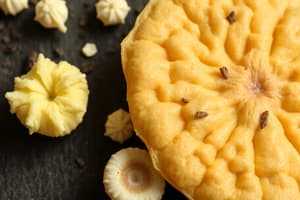Podcast
Questions and Answers
What is the primary structural form of yeasts?
What is the primary structural form of yeasts?
- Filamentous structures
- Multicellular networks
- True hyphae
- Unicellular (correct)
Which characteristic distinguishes moulds from yeasts?
Which characteristic distinguishes moulds from yeasts?
- Presence of pseudohyphae
- Growth as multiple tubular branches (correct)
- Formation of daughter cells by budding
- Ability to grow in anaerobic conditions
Where are yeasts typically found in nature?
Where are yeasts typically found in nature?
- In extreme cold regions
- In dry environments
- On fruit and in the oral cavity (correct)
- On wet soil
What is a distinctive feature of moulds regarding their cellular structure?
What is a distinctive feature of moulds regarding their cellular structure?
How do yeasts reproduce?
How do yeasts reproduce?
Which of the following best describes the appearance of yeasts?
Which of the following best describes the appearance of yeasts?
What type of habitats do moulds prefer?
What type of habitats do moulds prefer?
What color appearance is typical for yeasts compared to moulds?
What color appearance is typical for yeasts compared to moulds?
What is one significant role that fungi play in ecosystems?
What is one significant role that fungi play in ecosystems?
Which of the following fungi is known for its medicinal use in producing antibiotics?
Which of the following fungi is known for its medicinal use in producing antibiotics?
How do mycorrhizal fungi benefit agricultural plants?
How do mycorrhizal fungi benefit agricultural plants?
Which of the following statements about Stachybotrys is true?
Which of the following statements about Stachybotrys is true?
What role do fungi play in food production?
What role do fungi play in food production?
Which component found in the cell walls of fungi distinguishes them from plants?
Which component found in the cell walls of fungi distinguishes them from plants?
What term describes fungi that obtain nutrients by decomposing dead organic matter?
What term describes fungi that obtain nutrients by decomposing dead organic matter?
Which of the following is a reproductive method utilized by fungi?
Which of the following is a reproductive method utilized by fungi?
What characteristic specifically defines moulds as fungi?
What characteristic specifically defines moulds as fungi?
Under what conditions do moulds typically thrive?
Under what conditions do moulds typically thrive?
What type of organisms do moulds most commonly form beneficial relationships with?
What type of organisms do moulds most commonly form beneficial relationships with?
Which fungus is known for being found in soil and decaying vegetation and has various applications in fermentation?
Which fungus is known for being found in soil and decaying vegetation and has various applications in fermentation?
What is a unique feature of spores produced by moulds?
What is a unique feature of spores produced by moulds?
Study Notes
Fungi: Yeast vs. Mould
- Fungi are eukaryotic organisms.
- Candida is a key fungus in dentistry.
- Fungi exist in two forms: yeast and mould; some are dimorphic (both forms).
Yeast Characteristics
- Form: Grow as large single cells.
- Cell Type: Unicellular.
- Habitat: Widespread; found on fruit, in the stomach of mammals, oral cavity, and vaginal areas.
- Appearance: White and thready, usually oval.
- Hyphae: Lack true hyphae; instead form pseudohyphae (multicellular structures).
- Spores: Not a sporing species.
- Colour: Less colourful than moulds; generally colourless, collectively appearing creamy yellow.
- Oxygen: Can grow aerobically and anaerobically.
- Health Risks: Can cause infection in immunocompromised individuals.
- Reproduction: Often exhibits lateral projections (daughter cells) budding from the mother cell; some reproduce by binary fission. Pseudohyphae are chains of elongated budding cells; Candida forms these in the oral cavity.
Mould Characteristics
- Form: Grow as multiple tubular branches.
- Cell Type: Multicellular.
- Habitat: Typically found in damp, dark, or humid areas.
- Appearance: Fluffy appearance, various shapes.
- Hyphae: Composed of microscopic filaments called hyphae.
- Spores: Spore-producing fungus.
- Colour: Very colourful; can be orange, green, black, brown, pink, or purple.
Fungi: An Overview
- Diverse eukaryotic organisms including yeasts, molds, and mushrooms.
- Classified in their own kingdom, separate from plants, animals, and bacteria.
- Possess complex cells with a nucleus and membrane-bound organelles (eukaryotic).
- Cell walls contain chitin, unlike the cellulose in plant cell walls.
- Heterotrophic nutrition: obtain nutrients by absorbing organic matter. Includes saprophytic (decomposing dead matter), parasitic (feeding on living hosts), and mutualistic (beneficial relationships, e.g., mycorrhizae) types.
- Reproduction: asexual (spores, budding, fragmentation) and sexual (fusion of specialized structures/cells, spore formation).
- Growth forms: unicellular yeasts and multicellular molds (filamentous hyphae).
Molds: A Closer Look
- Multicellular fungi with filamentous hyphae.
- Important decomposers in ecosystems.
- Composed of a hyphae network that spreads over surfaces and penetrates substrates.
- Thrive in warm, humid environments on various organic materials (food, wood, fabrics).
- Reproduce via spores (air, water, insect dispersal); spores can remain dormant.
- Display a variety of colors (green, black, white, etc.) depending on spore type and substrate.
Common Mold Types
- Aspergillus: Found in soil and decaying vegetation; some species used in fermentation, others produce toxins.
- Penicillium: Produces penicillin and used in cheese production.
- Rhizopus: Found on bread and fruits; some species cause food spoilage.
- Stachybotrys ("black mold"): Produces mycotoxins harmful to health; often found in damp environments.
Significance of Fungi and Molds
- Ecological Role: Essential in nutrient cycling and decomposition.
- Food Production: Crucial in making bread, cheese, beer, and wine.
- Medicinal Uses: Source of antibiotics (e.g., penicillin) and other bioactive compounds.
- Biotechnology: Used in genetic research, enzyme production, and bioremediation.
- Agriculture: Mycorrhizal fungi enhance plant nutrient uptake and growth.
Studying That Suits You
Use AI to generate personalized quizzes and flashcards to suit your learning preferences.
Related Documents
Description
Explore the fascinating world of fungi, focusing on the distinctions between yeast and mould. This quiz covers their characteristics, growth habits, and health implications, particularly highlighting Candida as a significant fungus in dentistry. Test your knowledge on this vital topic in microbiology!



